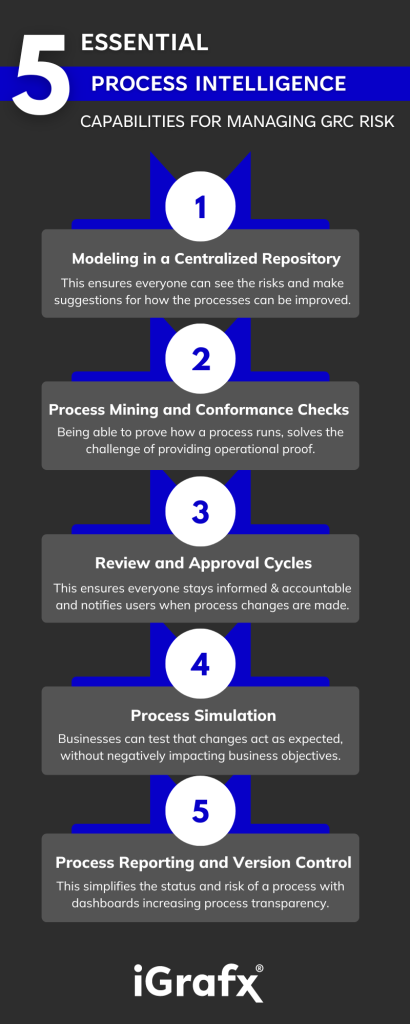When you ask about recent examples of companies grappling with Governance, Risk and Compliance (GRC) issues, business leaders might mention entities like Silicon Valley Bank. These are organizations that have been thrust into the spotlight, not for commendable reasons, but due to their struggles with GRC. When it comes to addressing GRC challenges, understanding process intelligence for managing GRC is paramount.
The businesses you generally don’t hear about are those who got it right. These companies ensured they stayed compliant and kept out of the news as a result. Almost always, we will find them engaging in proactive GRC process management amid a barrage of regulatory changes.
But before taking a look at their strategies, let’s examine the typical challenges businesses encounter in the realm of managing GRC.
Risky business
A core part of the challenge for many businesses is that their GRC function is siloed. This makes it hard to keep track of risk and compliance, and results in several avoidable problems.
Lack of alignment: Having a dedicated, access-limited GRC system has its benefits. However, it often means that frontline business units aren’t aligned with measures being rolled out by the compliance team managing GRC. This can also create challenges if internal audit teams don’t have immediate access to all the latest information.
Lack of ownership and accountability: As a knock-on effect, teams may not be taking ownership of the risks in their departments. In the worst cases, they may not even be aware of all their risks and the controls used to mitigate them.
Difficulty providing operational proof: Without clear documentation of how a process conforms to risk and compliance standards, companies often face challenges during external audits. Having well-defined risk management strategies and controls in place is great. But, you still need to prove that those controls are effective.
Difficulty modeling the operational impacts of new policies: With new legislation, it may be hard to anticipate the downstream effects of changes to workflows and operations. At best, this incurs costs in time and money. At worst, it leads to non-compliance and exposes the organization to larger financial and reputational risk.
Mapping out processes to minimize risk in GRC
These challenges share a common theme: a lack of process alignment and transparency. When the right hand doesn’t know what the left hand is doing, businesses can struggle to handle their risks and stay compliant with managing GRC.
To solve the issue, many businesses turn to process intelligence for managing GRC. They want to better understand their process landscape and optimize how their processes work. They hope this will enable them to stay compliant with both external regulations and internal policy.
But what becomes important at this stage is the company’s selection of process intelligence technology. Achieving true process alignment and transparency requires software equipped with key capabilities:
Process modeling in a centralized repository: Solving the alignment issue requires that everyone involved in a process knows and understands the risks and their mitigating controls. A good solution will enable the business to model processes, both as they are and as they should be, for managing GRC. But it should also make those models available through a centrally accessible process repository. This ensures that everyone can both see the risks and make suggestions for how the processes can be improved.
Now, this doesn’t mean that everyone should have the authority to catalog risks and create controls for managing GRC. A lot of that work can still happen in the business’s existing GRC system, which continues to serve as the system of reference. But everyone should be able to see what those risks are, where in the process they occur, and how to mitigate them.
Ideally, any changes made in managing GRC should be automatically imported back into the central process repository. This ensures ongoing alignment. Processes in the repository should also be linked in such a way that any changes to a specific process step reflect holistic effects. In other words, it should be easy to see how changes affect other business processes, systems, and individual teams for managing GRC.
Process mining and conformance checks: Process mining provides a way to check how processes are running. Are things working as designed? And are processes conforming to the controls and checks put in place to ensure the business stays compliant? Being able to prove how a process runs, solves the challenge of providing operational proof for managing GRC. This minimizes the time and difficulty associated with auditing processes.
Review and approval cycles: The chosen solution should also be able to ensure everyone stays informed and accountable. For example, it should notify relevant users when a change to a process has been made. It could then also require them to acknowledge that they’ve seen those changes.
Process simulation: Using process simulation, proposed process changes can be visualized and tested for managing GRC. This empowers the business to minimize the impacts of those changes. Importantly, it allows the business to test that the changes perform as expected to control risk and ensure compliance, without negatively impacting other business objectives.
Process reporting and version control: The solution should also simplify viewing the status and associated risks of a process. Dashboards and summaries can increase process transparency. And heat maps can be used to quickly spot areas or teams where there is high risk. Process changes should also be captured in a structured way to allow for version control. Then, when process changes are made that could impact GRC, it’s easy to pinpoint the “who, what, and where” that led to the decision.
Managing GRC with Process360 Live
In an increasingly complex regulatory environment, these capabilities are not merely nice to have. They enable businesses to manage their GRC landscape effectively. Process changes can be made that are both compliant and designed to maximize business value.
Those principles are also a core part of iGrafx’s approach to process intelligence that supports GRC. Besides offering the capabilities discussed, our Process360 Live platform empowers companies to make continuous improvements to their process landscape, one rooted in our unique “Discover, Design, Optimize” methodology. Process360 Live also integrates with existing GRC systems (e.g. Archer) to import existing risk & control catalogs into your process repository. This keeps everyone in the company in the loop about what’s happening and what they’re responsible for.
What all this adds up to is a process landscape that doesn’t leave you with the nagging suspicion that your company’s GRC efforts might not be enough.
The proof that things are working as intended is right in front of you. And this leaves everyone free to focus on what’s important: building business value that gets you into the headlines for all the right reasons.
Interested in learning how iGrafx’s process optimization capabilities can support your company’s GRC function? Contact us for a free trial.


